- Home
- Gary Vaynerchuk
Crushing It! EPB Page 14
Crushing It! EPB Read online
Page 14
How I’m Crushing It
Chithra Durgam, DDS, Aesthetic Dental
IG: drdurgam
Dr. Chithra Durgam has accomplished the near impossible—she’s made it fun to go to the dentist. How else can you explain the fact that many of her first-time clients call her at the request of their children? Let me explain.
When Chithra started her private practice in 2004, she did what most medical practitioners do to get referrals: she sent out direct-mail pieces to let her northern New Jersey neighbors know she was open for business. Social media, she thought, was for personal use. It wasn’t until she started following a social-media expert online, and then read his book Crush It!, that her thinking shifted and she understood how building a personal brand on social media could help grow a business. She was intrigued but hesitated to start. Doctors and dentists are constrained by a lot of HIPAA rules, and “we tend to be overly concerned about what each other thinks about the marketing we’re doing.” But she gave it a lot of thought and decided that “instead of using my free time to go golfing, if I’m using that time to interact with my patients, and educate people in a fun way about dentistry, there can’t be anything wrong with that. And so I kind of just took a leap of faith.”
For years, she has spent four to five hours every day, her lunch hour and the time she has after her two boys go to bed, on social media, engaging, reacting, and educating. She has a presence on all the usual suspects—Twitter, Facebook, Instagram, and she has written posts for Medium—but what sets Chithra apart from almost anyone over the age of twenty-five, and certainly from any medical practitioner, is that she’s on Musical.ly, too. And that’s why so many kids beg their parents to bring them to see her.
She creates lip-synced music videos about different procedures, like tooth whitening. She does PSA announcements about healthy eating, mouthing the words of a spoof version of Ed Sheeran’s “Shape of You.” Sometimes she posts an educational clip, like the one pointing out the difference between a porcelain crown and a veneer. She dances. She does comedy, often in a white jacket, sometimes wielding a toothbrush. She’s goofy and awkward, and while that might be all she was, were she just another muser, the fact that she’s a forty-four-year-old dentist makes the whole deal pretty hilarious. The comments and responses she gets from the young users there are overwhelmingly positive, and two of her clips were featured by the platform. Her young patients, the ones in the Musical.ly age bracket, follow her. They bring their phones to school and show their friends. And their friends say, “Mom, look at this video. I want to go to this dentist.”
Chithra gets a similar response from Snapchat, where she creates content tailored for a slightly older crowd. There she has a weekly series called The Office, modeled after the hit television show of the same name. She and members of her staff have also staged scenes from Charlie’s Angels and created snaps and stories using Bitmojis, music, and props. She used to try to document, but her audience responded so positively to her creative work that now she focuses on that instead.
Many of the people who find her on Musical.ly and Snapchat can’t come to her office because they live too far away, but on Instagram, where she can target more locally, she has a higher conversion rate; people DM her for appointments all the time. In the year since she got serious about pumping out consistent, quality content to these three platforms in addition to all the others, not just every so often, she has seen a 30 percent increase in new patients, with three to four inquiries about braces and whitening procedures per day coming in via DM.
Not only that, Lew Leone, vice president and general manager of WNYW-FOX 5, saw her on Snapchat and invited her to come to Good Day New York to talk about flossing after an Associated Press report published that it may be unnecessary. For the record, Dr. Durgam is pro-flossing.
Since then she’s been invited to speak about personal branding at meetings and on podcasts. She is currently working with different brands to help them develop ideas to promote their products through social media, and she has received inquiries from other dentists and doctors asking her for social-media consults, too. “I have taken time to learn all aspects of developing a brand before pursuing this work. I understand that I do have something valuable to offer.”
Most of her professional colleagues still don’t get it.
I’ve actually gotten a lot of pushback from people and other businesses. They want a return on their efforts right away; they don’t understand why I’m investing time. They don’t understand that social media is a long game and that it’s about developing a brand as much as it is about selling a product. And if nothing else, at least you develop rapport with people who come to your business. But they don’t really see that. So it’s been a little lonely because I’m doing work that I believe in even though those people around me may not agree with my methods.
Even some of her clients wonder how she has time to put out so many videos. “And then I’ll have to say, my staff and I are very serious about our work, but when we’re not working, we would rather spend our free time interacting with patients and educating them, as opposed to doing something that’s only in our self-interest. Once I’ve explained our intention, it’s been fine. I’m kind of going against everybody else right now, but I think over time people will understand social media is very important to business.”
One of the reasons I’m so excited about this book is because when I wrote Crush It!, I didn’t have access to a lot of examples of other people using the platforms the way I was. I was just too early. But now, armed with stories like Chithra’s, I can suffocate all of your excuses. Until ten minutes ago, you might not have even heard of Musical.ly; now you know that a dentist is out there using it and other platforms to build her business. That’s awesome! Education and execution are the keys to this new world.
9
Snapchat
Despite its 173 million daily active users (DAU), its 10 billion daily video views, its 2.5 billion daily snaps, and the approximately 18 visits it enjoys from its DAU per day,1 Snapchat remains another massively underestimated platform. Let me clue you in to an important tell: when the “normals,” that is, the nontech, nonbusiness crowd, are the first to start spending inordinate amounts of time on a platform, that’s the signal to start paying close attention. That’s what drew me to Musical.ly early on, and it’s why I knew Snapchat had an exciting future when it first came out in 2011. I saw it as the first social network to closely re-create the way we communicate face-to-face.
Its founders, Evan Spiegel and Bobby Murphy, conceived it as the anti-Facebook, a photo-sharing app for spontaneous, imperfect, and impermanent content. When Snapchat first came on the scene in 2011, the messaging app’s vertical video and left-right swiping had people totally confused. It took most users, even the young, a few minutes to click around and get used to it. For teens, though, it was worth figuring out, because it addressed two universal adolescent realities: (1) You don’t want to hang where you mom hangs out, and (2) You want to lock your room. Because adults didn’t get it, because images “self-destructed” one to ten seconds after being opened, and because it gave you the option of drawing and writing text or captions on top of your pictures, the kids were quick to see its potential as texting 2.0—a freer, less curated, and less dangerous place than other platforms to share and creatively express themselves. And share they did; it became widely derided and even feared as the next sexting tool for the high school set (though it never really was a sexting app; that was just the media jumping on a select few cases and running with the attention-grabbing headlines). Today people don’t talk about sexting and Snapchat in the same breath anymore, just as people stopped sneering at Twitter for being the place where attention hogs posted what they ate for lunch, and at Facebook for being a place where college students shared their beer-pong pics.
Today the Snapchat app allows you to post video as well as photos and has added all kinds of extras, like filters, Geofilters, lenses, emojis, and video-editing to
ols like slo-mo. Content is no longer ephemeral. You could always hack by taking screenshots of images to save them, but with the addition of Memories, which stores your content on the app’s servers, Snapchat essentially caved in to the human desire to save and revisit the important moments of our lives. The game-changing introduction, however, and the one that would turn out to have the most influence on influencers, was Stories, a function that allows you to link a series of videos and photos to tell a longer narrative, visible to the whole Snapchat community for twenty-four hours. It arrived in 2013, and I very publicly pronounced it a dud.
You can watch me make my blunder emphatically and passionately at the LeWeb’13 conference on YouTube. I loved the platform, but I thought the change introduced too much friction in the UI and betrayed the whole point of the app, which was to create snack-size disappearing content. I was dead wrong. The Story feature became the main place where users could consume content at scale. Less than a year later, 40 percent of American teenagers were using Snapchat daily. I learned an important lesson from that bad call on Snapchat: a devoted, sticky fan base is willing to be patient as you experiment your way to the next iteration. The next big launch, Discover, saw Snapchat graduate into a bona fide media platform by offering a page where users would find a slew of brands like National Geographic, T-Mobile, and ESPN. Snapchat now had access to advertising revenue, and that meant so did anyone who could crack the Snapchat code.
The man who did that is named DJ Khaled, but before I introduce him, we’re going to reminisce about Ashton Kutcher. He wasn’t the first star on Twitter—big shout-out to MC Hammer (joined in May 2007) and LeVar Burton (joined in December 2008)—but after joining in January 2009, Kutcher was the first celebrity to truly scale his brand through the platform. Like Hammer and Burton, he’d been building his brand through talent and hustle for decades as a model, a sitcom and film actor, and a producer and director for the reality-TV show Punk’d. I often talk about Kutcher when I talk about the history of Twitter, because it was only four months after joining that he became the first Twitter user to boast one million followers, thanks to a brilliant campaign of challenging CNN to a race to hit the milestone. Suddenly Twitter, which had seemed like a joke to most people, was mainstream.
DJ Khaled created the Ashton Kutcher moment for Snapchat. For over two decades, he built a name for himself in the music industry as a Miami-based DJ, producer, and radio host. Khaled joined Snapchat in the fall of 2015, snapping inspirational and motivational “keys” to life and success. His fondness for the platform, he wrote in his memoir, The Keys, was that, “It’s not about the angle or editing or lighting or how good you look, it’s just you for ten seconds being real with your fans.”2 That authenticity had earned him a sizable fan base. By November or December of that year, anyone following social media could see that whatever it was he was doing, it was something special. Thousands of kids were showing up to meet his bus in places like Des Moines, Iowa. You could start to feel that the scale of Snapchat was shifting. Then, in December of that year, Khaled left a friend’s house by jet ski, only to get caught off guard by the waning early-winter light. Disoriented in the now pitch-black water, he proceeded to snap his entire ordeal until he finally made it back to shore. By the next day, his popularity—and his personal brand—had exploded. DJ Khaled made it official: Snapchat was now a star-making vehicle.
So how did Khaled do it? How does a grown-up become famous on a platform that serves as a communication tool among tweens and teens? By not overthinking anything. Unpolished content is native to Snapchat, and Khaled just was who he was. Some people might call such banal, spontaneous content dumb and worthless, but that would be like saying that the minutiae of our lives are dumb and worthless. They’re not. When combined, those raw, unfiltered moments make up who we are. We don’t judge mundane behavior as dumb when we interact with people; we save such judgment for truly dumb behavior. We accept people in their natural habitats, and we understand that every word people utter is not going to be movie script–worthy. Snapchat is simply a channel that captures that unvarnished reality. The only reason some people think what gets shared there is dumb is because it’s on a screen, and we’ve been conditioned to think that anything on a screen has to be perfectly produced and performed. On Twitter we’re expected to be clever or politically astute and insightful. Facebook is where we show off our families and vacations. On Instagram we build relationships through images and short videos. Snapchat, though, is where we put our throwaway content. It’s a relief to many because it demands little of either its content creators or users. It eliminated the great barrier to many social networks, which is the anxiety of wondering what you’re going to post next, whether it will be well received, and whether it could come back to haunt you one day. With the freedom to post anything, people could experiment and get comfortable building their personal brands without fear of repercussions. That opened the floodgates for many to unleash their creativity and discover and develop new skills. More than one person has left a corporate job or fledgling startup because playing around on Snapchat led them to create a new art medium or become an influencer, which attracted brands eager to pay them tens of thousands of dollars to promote their products in Snapchat Stories.
It is staggering how many families are filming their days and building actual fame. It’s especially easy if you’re willing to include your children. That’s an extremely personal choice, but babies and cute animals always win, hands down. Kerry Robinson learned that when she used Snapchat to film herself engaging in #salontalk with her baby girl, Jayde, while Jayde took to her mom’s hair with a brush. Her Stories on Facebook went viral and garnered articles and TV segments in national media, from CBS News to Essence magazine. Today Jayde has her own ad-supported YouTube channel with seventy-four thousand subscribers and an Instagram account with more than two hundred thousand followers. You can watch a video of her opening a gift of children’s products from a hair care company and see a photo that expresses thanks for a T-shirt sent by a company that celebrates children with naturally curly hair. You couldn’t get a purer example of a person who is famous—and, it would seem, earning money—for simply being herself. That’s what can come from posting a single piece of excellent content. What will come of Jayde’s online celebrity in the long term remains to be seen, of course, but at a time when people are desperate for good news and uplifting, heartwarming content, a glimpse of your ordinary life could be just what they’re looking for.
Many people who have already gotten some brand traction and are becoming influencers, including some featured in this book, stopped producing content on Snapchat as soon as Instagram Stories came out in August 2016. The thinking was that Snapchat is toast. Why bother?
You bother because it’s a mistake to give up one of the tools in your tool belt for no reason. Hear this: Instagram and Snapchat are not the same. As always, people are looking for different things on each. Why would you deprive them? Sure, it’s hard. That’s the challenge. But that’s also the opportunity. Because it’s hard, only one in twenty of you is going to do it well. You should be busting your ass to be that one in twenty. I understand that you want to focus on what is giving you the best returns right now, but what if it doesn’t always? And why would you turn your back on a potentially whole new audience?
As I write this book, I’m constantly checking the App Store to see which platforms are ranked highest. Snapchat is often in the top five. That means it’s not an irrelevant platform, and no influencer is too good for it.
If anything, this app is one of the most valuable for anyone whose brand is starting to scale. Much of your competition has surely become too reliant and focused on Instagram, which means those potential eyeballs still on Snapchat are looking for more content to feed them. Make sure you’re the one to deliver it. It is so easy for influencers to become sucked into the vortex of the media machine they’ve created. You risk becoming a caricature of yourself, especially on Instagram, where the im
ages are so highly curated. As a feature within your Instagram ecosystem, Instagram Stories are almost required to stay within the lines and support the narrative you’ve created there. Snapchat, on the other hand, is an entity unto its own. You can use it to break away from the familiar narrative and show sides of yourself that simply don’t exist anywhere else. It gives you differentiated content. Whereas all your other channels intertwine with each other to support your pillar content, Snapchat stands alone. That’s an excellent reason in and of itself to take it seriously, even when its DNA makes it a natural draw for the mundane and the silly. It gives you a place to be surprising and different, often in the most ordinary, banal ways. (This is advice I should take to heart, too; I could do an even better job there myself!)
Snapchat 101
Back to the original question: how should grown-ups build their brands and dreams on a communication tool for tweens and teens?
Some people, like baby Jayde, have so much charisma that they’re going to go viral the minute they present themselves or their work in public. But those individuals are few. For the vast majority, it will take talent plus a combination of tactics and strategy to get noticed. Yet Snapchat limits those tactics. There are no hashtags, for example, so no discoverability. What that means is that building a brand on Snapchat is truly a test of your branding prowess. It’s not about running ads and quantifying every click and mathematical variable; it’s about hacking culture. Snapchat reveals who’s good at it and who’s not. This is why you shouldn’t wonder whether to bother with Snapchat now that Instagram has its own version of Stories. Whether or not Snapchat can compete over time, it’s a terrific training ground to become a superior marketer and branding expert, not just a conversion-based digital salesperson.

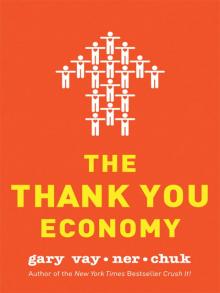 The Thank You Economy
The Thank You Economy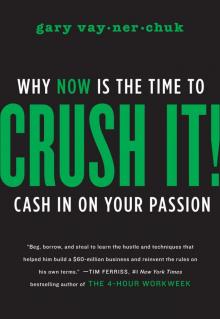 Crush It!
Crush It!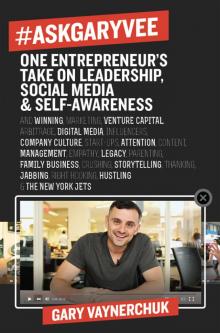 #AskGaryVee
#AskGaryVee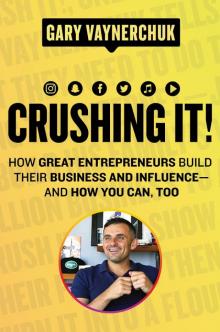 Crushing It! EPB
Crushing It! EPB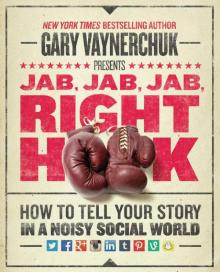 Jab, Jab, Jab, Right Hook
Jab, Jab, Jab, Right Hook